Case Study Analysis: Clinical Deterioration in Healthcare Setting
VerifiedAdded on 2022/09/22
|7
|1613
|31
Case Study
AI Summary
This case study analyzes a scenario involving a patient experiencing clinical deterioration and the subsequent actions of healthcare professionals. The case highlights the importance of timely recognition of deteriorating conditions, proper documentation, and effective communication using tools like ISBAR. The respondent, a healthcare professional, is criticized for negligence, including delayed response to the patient's symptoms and failure to follow established protocols. The analysis emphasizes the violation of NSQHS standards, particularly those related to recognizing and responding to clinical deterioration. Contributing factors to the patient's death, including lack of skills, poor documentation, and failure to utilize the rapid response system, are discussed. The implications for future practice include the need for improved training, adherence to standards, and utilization of hospital-wide systems to ensure patient safety. The case underscores the importance of accurate documentation, effective communication, and the use of rapid response systems to prevent adverse events and improve patient outcomes. References include relevant literature on clinical deterioration, nursing practice, and healthcare standards.
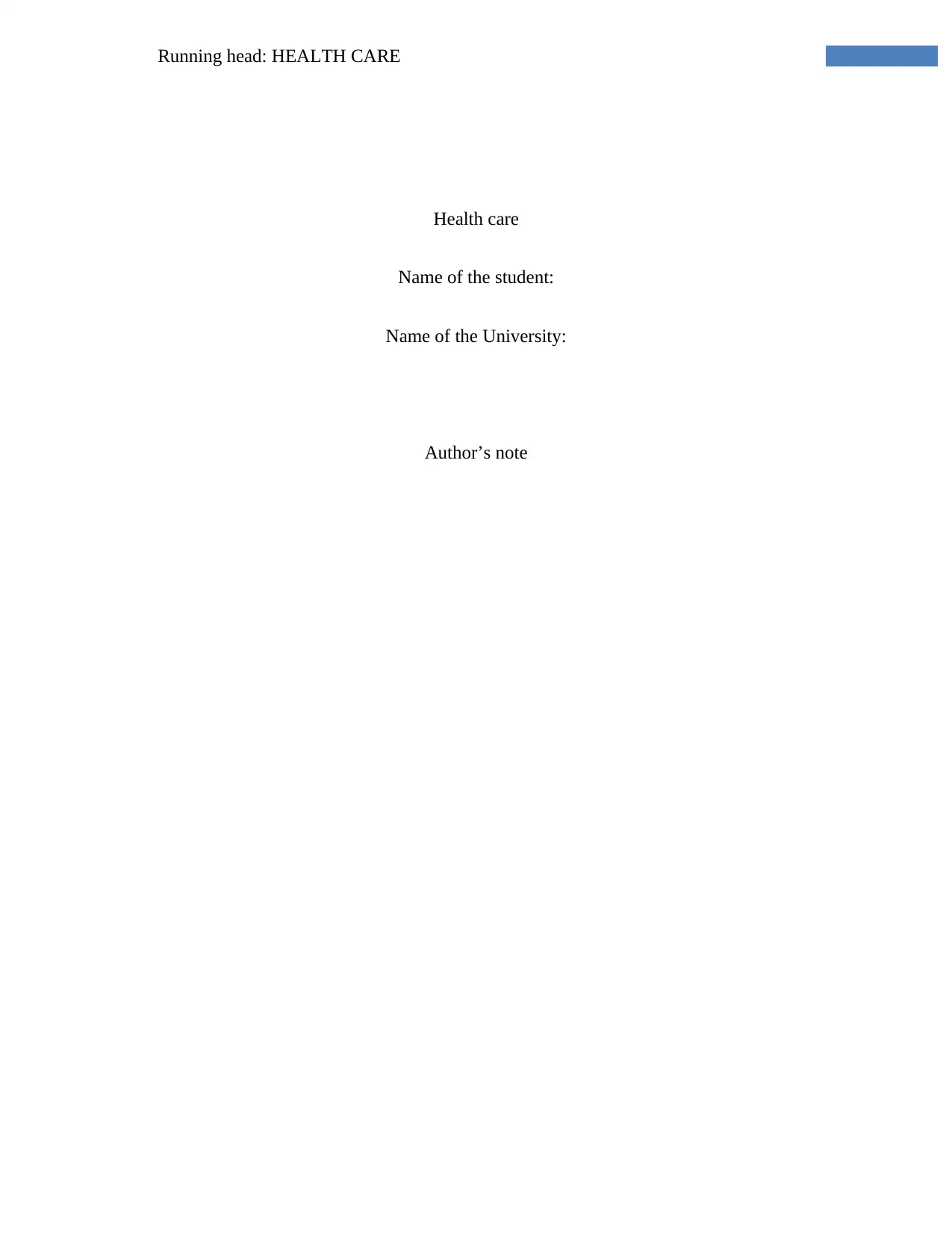
Running head: HEALTH CARE
Health care
Name of the student:
Name of the University:
Author’s note
Health care
Name of the student:
Name of the University:
Author’s note
Paraphrase This Document
Need a fresh take? Get an instant paraphrase of this document with our AI Paraphraser
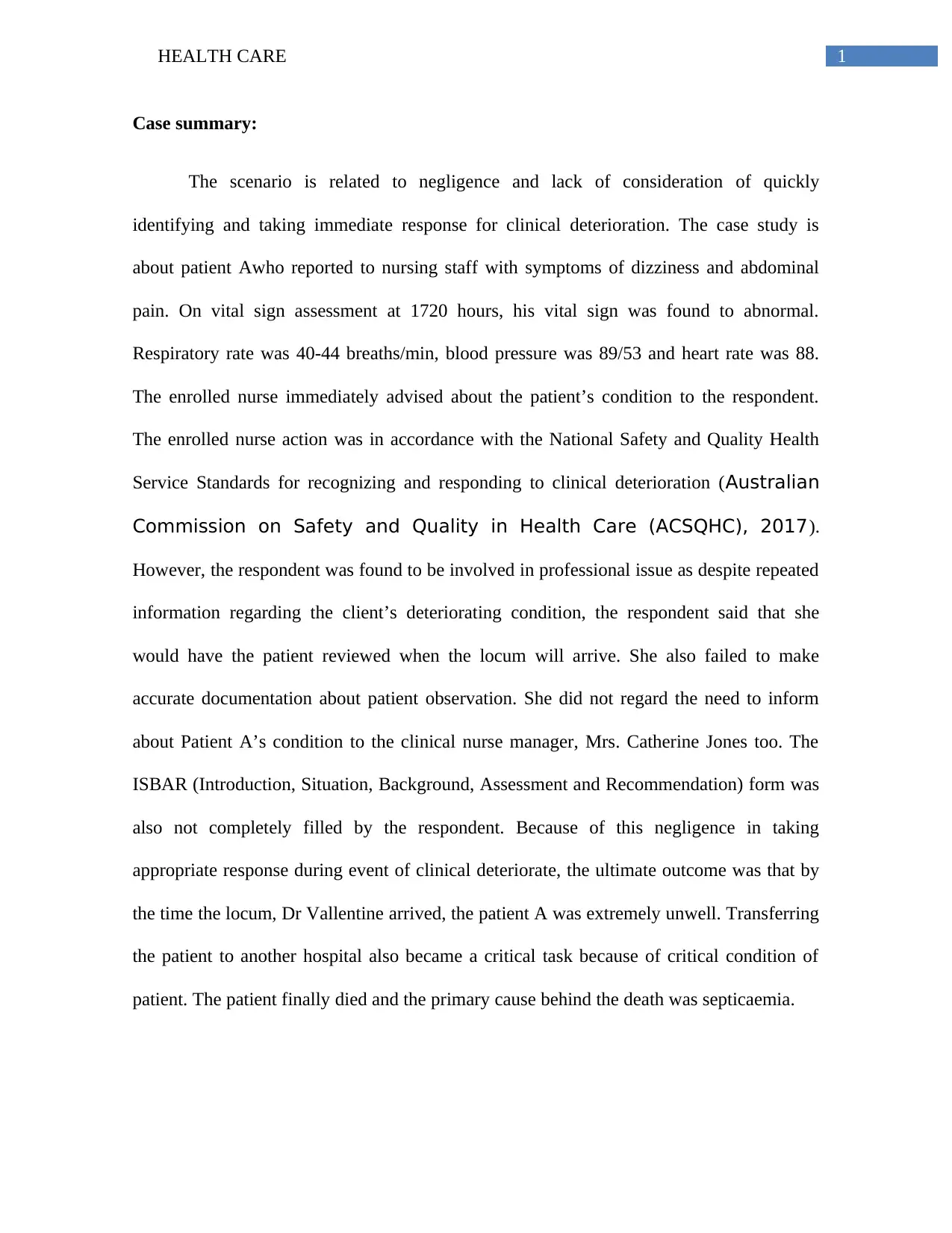
1HEALTH CARE
Case summary:
The scenario is related to negligence and lack of consideration of quickly
identifying and taking immediate response for clinical deterioration. The case study is
about patient Awho reported to nursing staff with symptoms of dizziness and abdominal
pain. On vital sign assessment at 1720 hours, his vital sign was found to abnormal.
Respiratory rate was 40-44 breaths/min, blood pressure was 89/53 and heart rate was 88.
The enrolled nurse immediately advised about the patient’s condition to the respondent.
The enrolled nurse action was in accordance with the National Safety and Quality Health
Service Standards for recognizing and responding to clinical deterioration (Australian
Commission on Safety and Quality in Health Care (ACSQHC), 2017).
However, the respondent was found to be involved in professional issue as despite repeated
information regarding the client’s deteriorating condition, the respondent said that she
would have the patient reviewed when the locum will arrive. She also failed to make
accurate documentation about patient observation. She did not regard the need to inform
about Patient A’s condition to the clinical nurse manager, Mrs. Catherine Jones too. The
ISBAR (Introduction, Situation, Background, Assessment and Recommendation) form was
also not completely filled by the respondent. Because of this negligence in taking
appropriate response during event of clinical deteriorate, the ultimate outcome was that by
the time the locum, Dr Vallentine arrived, the patient A was extremely unwell. Transferring
the patient to another hospital also became a critical task because of critical condition of
patient. The patient finally died and the primary cause behind the death was septicaemia.
Case summary:
The scenario is related to negligence and lack of consideration of quickly
identifying and taking immediate response for clinical deterioration. The case study is
about patient Awho reported to nursing staff with symptoms of dizziness and abdominal
pain. On vital sign assessment at 1720 hours, his vital sign was found to abnormal.
Respiratory rate was 40-44 breaths/min, blood pressure was 89/53 and heart rate was 88.
The enrolled nurse immediately advised about the patient’s condition to the respondent.
The enrolled nurse action was in accordance with the National Safety and Quality Health
Service Standards for recognizing and responding to clinical deterioration (Australian
Commission on Safety and Quality in Health Care (ACSQHC), 2017).
However, the respondent was found to be involved in professional issue as despite repeated
information regarding the client’s deteriorating condition, the respondent said that she
would have the patient reviewed when the locum will arrive. She also failed to make
accurate documentation about patient observation. She did not regard the need to inform
about Patient A’s condition to the clinical nurse manager, Mrs. Catherine Jones too. The
ISBAR (Introduction, Situation, Background, Assessment and Recommendation) form was
also not completely filled by the respondent. Because of this negligence in taking
appropriate response during event of clinical deteriorate, the ultimate outcome was that by
the time the locum, Dr Vallentine arrived, the patient A was extremely unwell. Transferring
the patient to another hospital also became a critical task because of critical condition of
patient. The patient finally died and the primary cause behind the death was septicaemia.
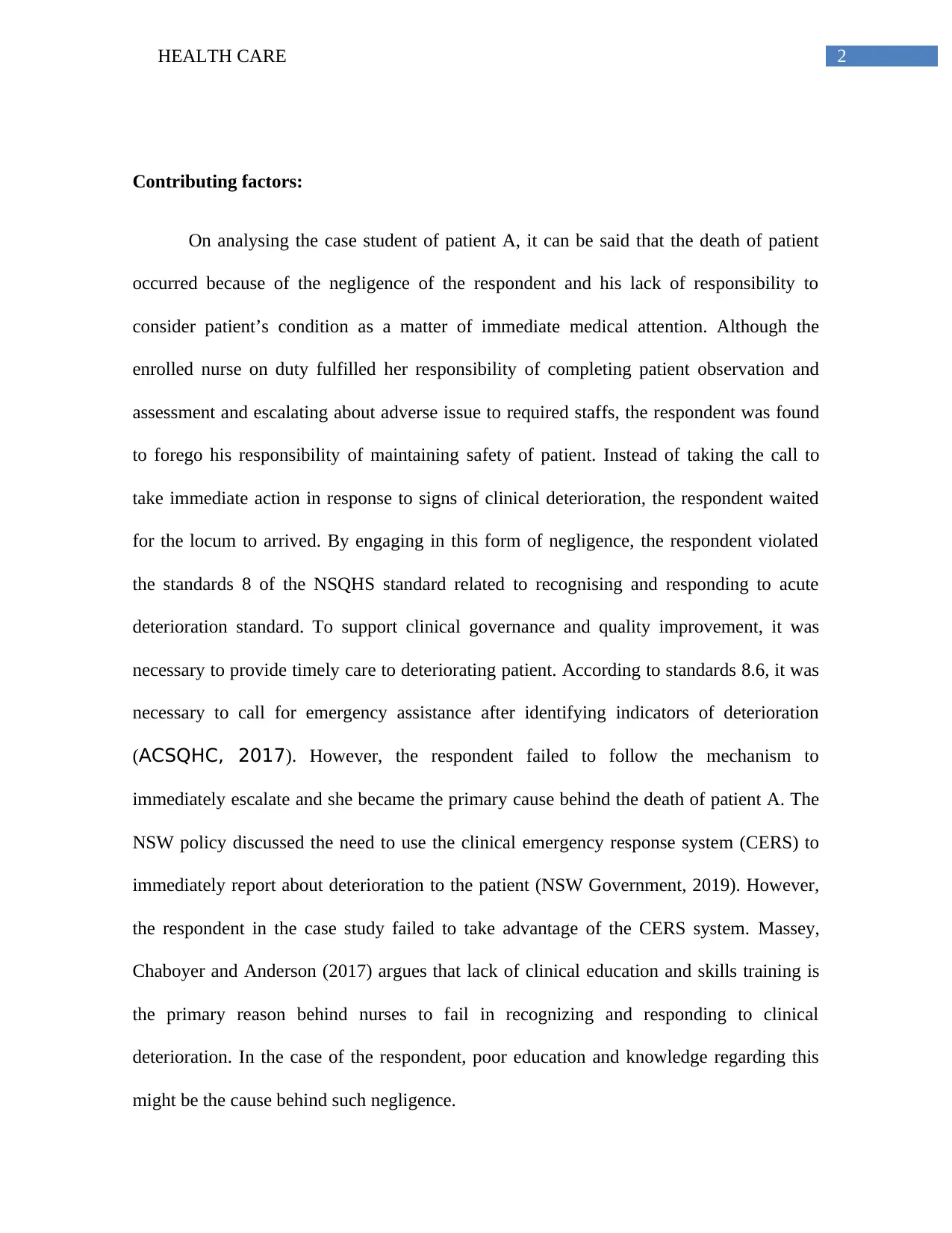
2HEALTH CARE
Contributing factors:
On analysing the case student of patient A, it can be said that the death of patient
occurred because of the negligence of the respondent and his lack of responsibility to
consider patient’s condition as a matter of immediate medical attention. Although the
enrolled nurse on duty fulfilled her responsibility of completing patient observation and
assessment and escalating about adverse issue to required staffs, the respondent was found
to forego his responsibility of maintaining safety of patient. Instead of taking the call to
take immediate action in response to signs of clinical deterioration, the respondent waited
for the locum to arrived. By engaging in this form of negligence, the respondent violated
the standards 8 of the NSQHS standard related to recognising and responding to acute
deterioration standard. To support clinical governance and quality improvement, it was
necessary to provide timely care to deteriorating patient. According to standards 8.6, it was
necessary to call for emergency assistance after identifying indicators of deterioration
(ACSQHC, 2017). However, the respondent failed to follow the mechanism to
immediately escalate and she became the primary cause behind the death of patient A. The
NSW policy discussed the need to use the clinical emergency response system (CERS) to
immediately report about deterioration to the patient (NSW Government, 2019). However,
the respondent in the case study failed to take advantage of the CERS system. Massey,
Chaboyer and Anderson (2017) argues that lack of clinical education and skills training is
the primary reason behind nurses to fail in recognizing and responding to clinical
deterioration. In the case of the respondent, poor education and knowledge regarding this
might be the cause behind such negligence.
Contributing factors:
On analysing the case student of patient A, it can be said that the death of patient
occurred because of the negligence of the respondent and his lack of responsibility to
consider patient’s condition as a matter of immediate medical attention. Although the
enrolled nurse on duty fulfilled her responsibility of completing patient observation and
assessment and escalating about adverse issue to required staffs, the respondent was found
to forego his responsibility of maintaining safety of patient. Instead of taking the call to
take immediate action in response to signs of clinical deterioration, the respondent waited
for the locum to arrived. By engaging in this form of negligence, the respondent violated
the standards 8 of the NSQHS standard related to recognising and responding to acute
deterioration standard. To support clinical governance and quality improvement, it was
necessary to provide timely care to deteriorating patient. According to standards 8.6, it was
necessary to call for emergency assistance after identifying indicators of deterioration
(ACSQHC, 2017). However, the respondent failed to follow the mechanism to
immediately escalate and she became the primary cause behind the death of patient A. The
NSW policy discussed the need to use the clinical emergency response system (CERS) to
immediately report about deterioration to the patient (NSW Government, 2019). However,
the respondent in the case study failed to take advantage of the CERS system. Massey,
Chaboyer and Anderson (2017) argues that lack of clinical education and skills training is
the primary reason behind nurses to fail in recognizing and responding to clinical
deterioration. In the case of the respondent, poor education and knowledge regarding this
might be the cause behind such negligence.
⊘ This is a preview!⊘
Do you want full access?
Subscribe today to unlock all pages.

Trusted by 1+ million students worldwide
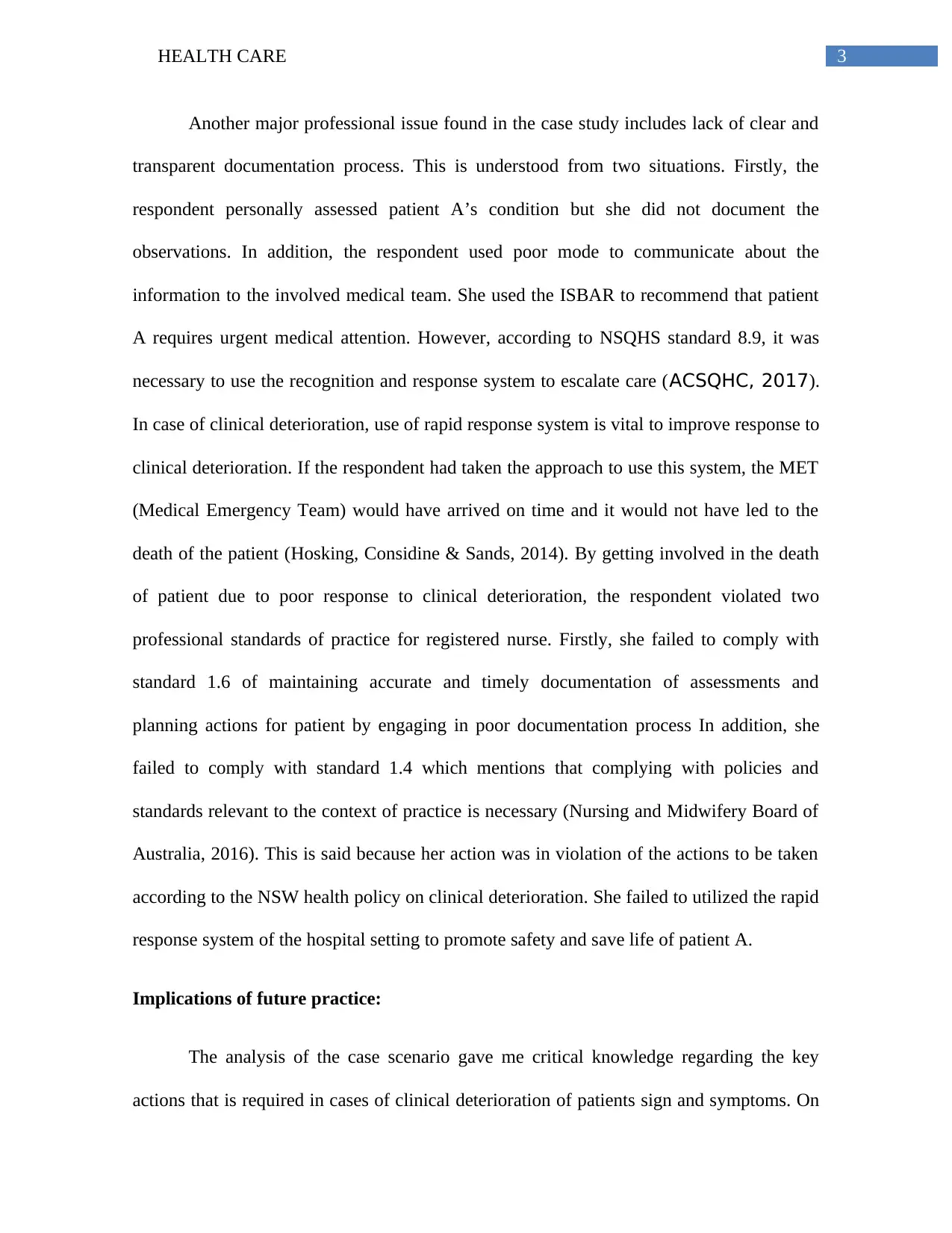
3HEALTH CARE
Another major professional issue found in the case study includes lack of clear and
transparent documentation process. This is understood from two situations. Firstly, the
respondent personally assessed patient A’s condition but she did not document the
observations. In addition, the respondent used poor mode to communicate about the
information to the involved medical team. She used the ISBAR to recommend that patient
A requires urgent medical attention. However, according to NSQHS standard 8.9, it was
necessary to use the recognition and response system to escalate care (ACSQHC, 2017).
In case of clinical deterioration, use of rapid response system is vital to improve response to
clinical deterioration. If the respondent had taken the approach to use this system, the MET
(Medical Emergency Team) would have arrived on time and it would not have led to the
death of the patient (Hosking, Considine & Sands, 2014). By getting involved in the death
of patient due to poor response to clinical deterioration, the respondent violated two
professional standards of practice for registered nurse. Firstly, she failed to comply with
standard 1.6 of maintaining accurate and timely documentation of assessments and
planning actions for patient by engaging in poor documentation process In addition, she
failed to comply with standard 1.4 which mentions that complying with policies and
standards relevant to the context of practice is necessary (Nursing and Midwifery Board of
Australia, 2016). This is said because her action was in violation of the actions to be taken
according to the NSW health policy on clinical deterioration. She failed to utilized the rapid
response system of the hospital setting to promote safety and save life of patient A.
Implications of future practice:
The analysis of the case scenario gave me critical knowledge regarding the key
actions that is required in cases of clinical deterioration of patients sign and symptoms. On
Another major professional issue found in the case study includes lack of clear and
transparent documentation process. This is understood from two situations. Firstly, the
respondent personally assessed patient A’s condition but she did not document the
observations. In addition, the respondent used poor mode to communicate about the
information to the involved medical team. She used the ISBAR to recommend that patient
A requires urgent medical attention. However, according to NSQHS standard 8.9, it was
necessary to use the recognition and response system to escalate care (ACSQHC, 2017).
In case of clinical deterioration, use of rapid response system is vital to improve response to
clinical deterioration. If the respondent had taken the approach to use this system, the MET
(Medical Emergency Team) would have arrived on time and it would not have led to the
death of the patient (Hosking, Considine & Sands, 2014). By getting involved in the death
of patient due to poor response to clinical deterioration, the respondent violated two
professional standards of practice for registered nurse. Firstly, she failed to comply with
standard 1.6 of maintaining accurate and timely documentation of assessments and
planning actions for patient by engaging in poor documentation process In addition, she
failed to comply with standard 1.4 which mentions that complying with policies and
standards relevant to the context of practice is necessary (Nursing and Midwifery Board of
Australia, 2016). This is said because her action was in violation of the actions to be taken
according to the NSW health policy on clinical deterioration. She failed to utilized the rapid
response system of the hospital setting to promote safety and save life of patient A.
Implications of future practice:
The analysis of the case scenario gave me critical knowledge regarding the key
actions that is required in cases of clinical deterioration of patients sign and symptoms. On
Paraphrase This Document
Need a fresh take? Get an instant paraphrase of this document with our AI Paraphraser
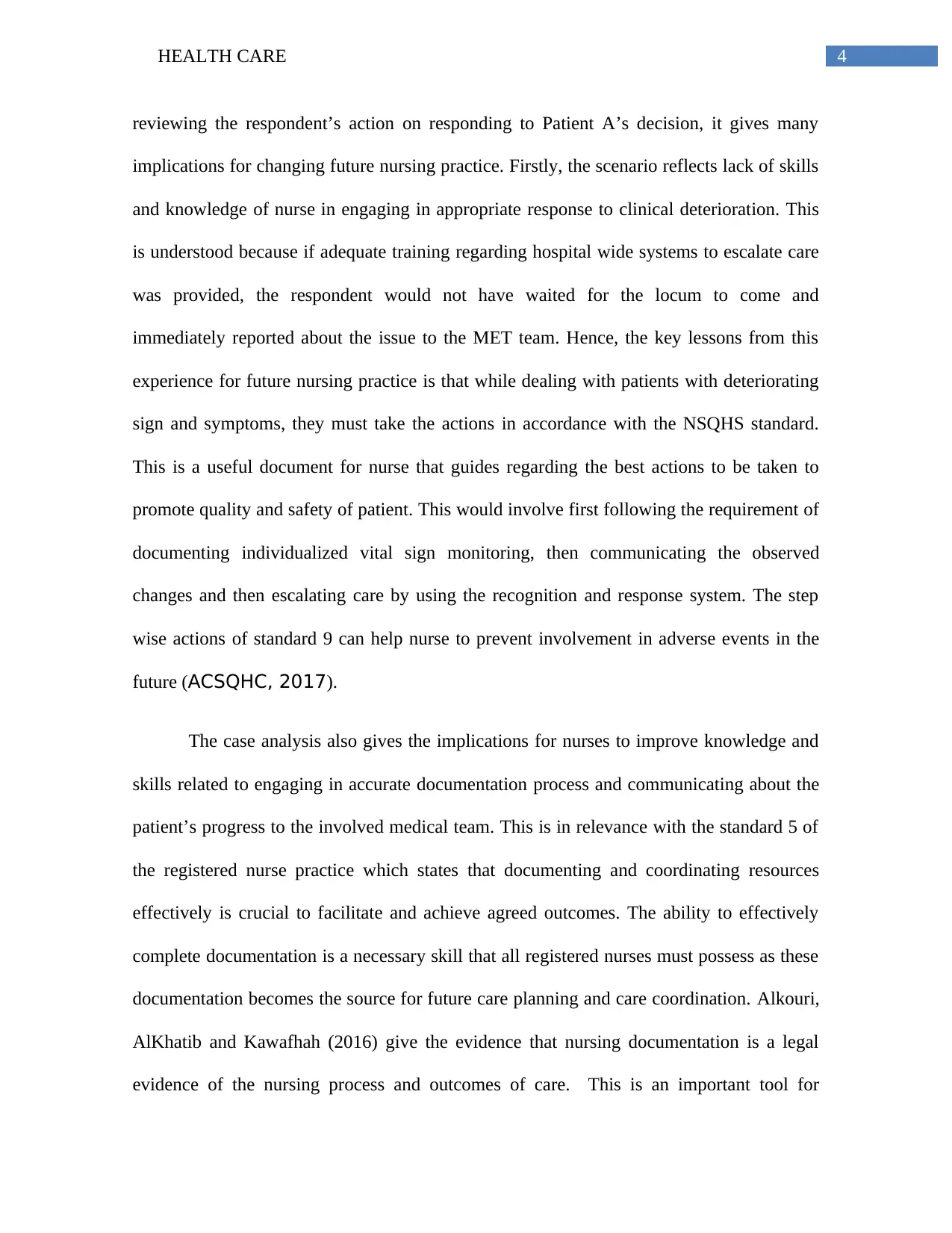
4HEALTH CARE
reviewing the respondent’s action on responding to Patient A’s decision, it gives many
implications for changing future nursing practice. Firstly, the scenario reflects lack of skills
and knowledge of nurse in engaging in appropriate response to clinical deterioration. This
is understood because if adequate training regarding hospital wide systems to escalate care
was provided, the respondent would not have waited for the locum to come and
immediately reported about the issue to the MET team. Hence, the key lessons from this
experience for future nursing practice is that while dealing with patients with deteriorating
sign and symptoms, they must take the actions in accordance with the NSQHS standard.
This is a useful document for nurse that guides regarding the best actions to be taken to
promote quality and safety of patient. This would involve first following the requirement of
documenting individualized vital sign monitoring, then communicating the observed
changes and then escalating care by using the recognition and response system. The step
wise actions of standard 9 can help nurse to prevent involvement in adverse events in the
future (ACSQHC, 2017).
The case analysis also gives the implications for nurses to improve knowledge and
skills related to engaging in accurate documentation process and communicating about the
patient’s progress to the involved medical team. This is in relevance with the standard 5 of
the registered nurse practice which states that documenting and coordinating resources
effectively is crucial to facilitate and achieve agreed outcomes. The ability to effectively
complete documentation is a necessary skill that all registered nurses must possess as these
documentation becomes the source for future care planning and care coordination. Alkouri,
AlKhatib and Kawafhah (2016) give the evidence that nursing documentation is a legal
evidence of the nursing process and outcomes of care. This is an important tool for
reviewing the respondent’s action on responding to Patient A’s decision, it gives many
implications for changing future nursing practice. Firstly, the scenario reflects lack of skills
and knowledge of nurse in engaging in appropriate response to clinical deterioration. This
is understood because if adequate training regarding hospital wide systems to escalate care
was provided, the respondent would not have waited for the locum to come and
immediately reported about the issue to the MET team. Hence, the key lessons from this
experience for future nursing practice is that while dealing with patients with deteriorating
sign and symptoms, they must take the actions in accordance with the NSQHS standard.
This is a useful document for nurse that guides regarding the best actions to be taken to
promote quality and safety of patient. This would involve first following the requirement of
documenting individualized vital sign monitoring, then communicating the observed
changes and then escalating care by using the recognition and response system. The step
wise actions of standard 9 can help nurse to prevent involvement in adverse events in the
future (ACSQHC, 2017).
The case analysis also gives the implications for nurses to improve knowledge and
skills related to engaging in accurate documentation process and communicating about the
patient’s progress to the involved medical team. This is in relevance with the standard 5 of
the registered nurse practice which states that documenting and coordinating resources
effectively is crucial to facilitate and achieve agreed outcomes. The ability to effectively
complete documentation is a necessary skill that all registered nurses must possess as these
documentation becomes the source for future care planning and care coordination. Alkouri,
AlKhatib and Kawafhah (2016) give the evidence that nursing documentation is a legal
evidence of the nursing process and outcomes of care. This is an important tool for
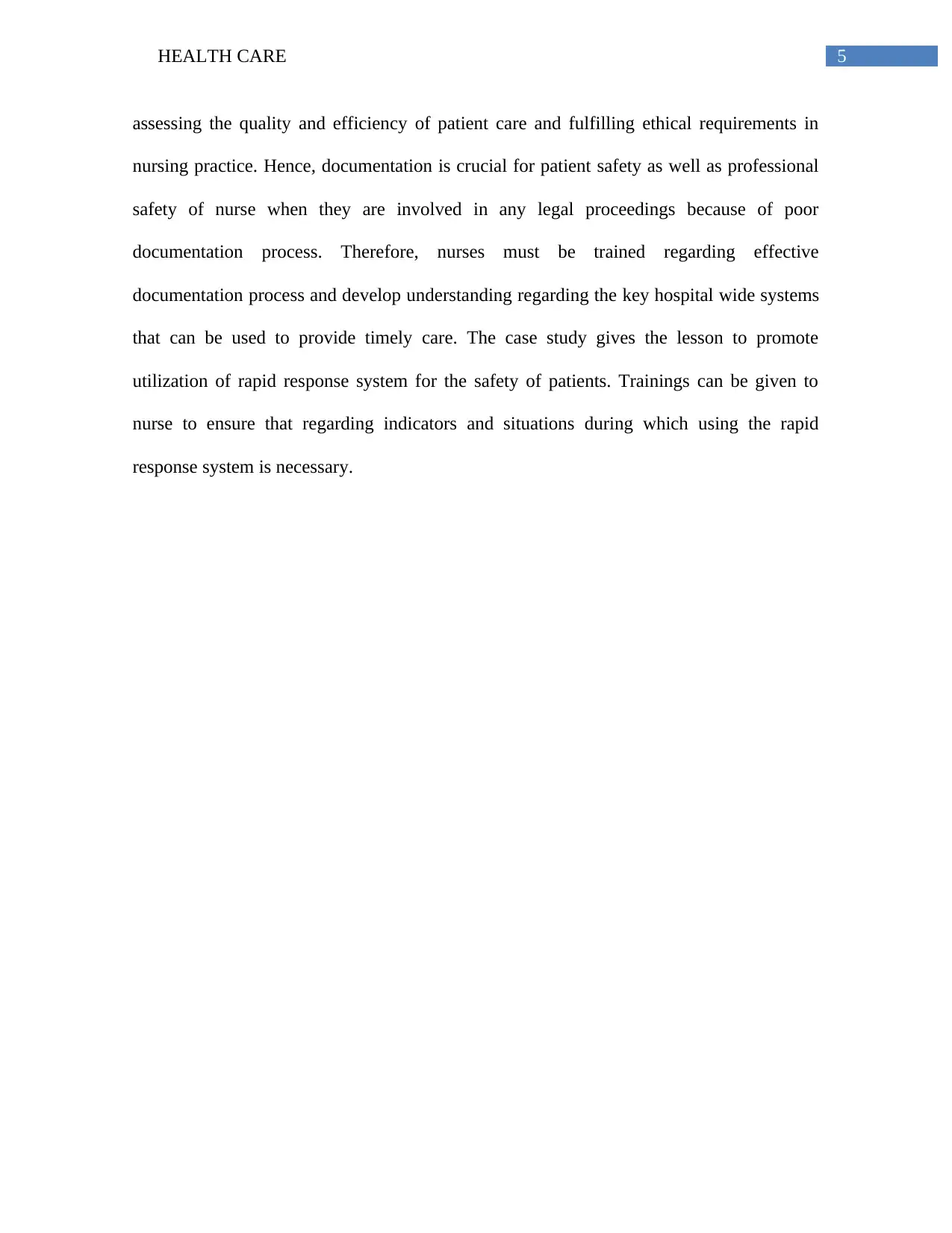
5HEALTH CARE
assessing the quality and efficiency of patient care and fulfilling ethical requirements in
nursing practice. Hence, documentation is crucial for patient safety as well as professional
safety of nurse when they are involved in any legal proceedings because of poor
documentation process. Therefore, nurses must be trained regarding effective
documentation process and develop understanding regarding the key hospital wide systems
that can be used to provide timely care. The case study gives the lesson to promote
utilization of rapid response system for the safety of patients. Trainings can be given to
nurse to ensure that regarding indicators and situations during which using the rapid
response system is necessary.
assessing the quality and efficiency of patient care and fulfilling ethical requirements in
nursing practice. Hence, documentation is crucial for patient safety as well as professional
safety of nurse when they are involved in any legal proceedings because of poor
documentation process. Therefore, nurses must be trained regarding effective
documentation process and develop understanding regarding the key hospital wide systems
that can be used to provide timely care. The case study gives the lesson to promote
utilization of rapid response system for the safety of patients. Trainings can be given to
nurse to ensure that regarding indicators and situations during which using the rapid
response system is necessary.
⊘ This is a preview!⊘
Do you want full access?
Subscribe today to unlock all pages.

Trusted by 1+ million students worldwide
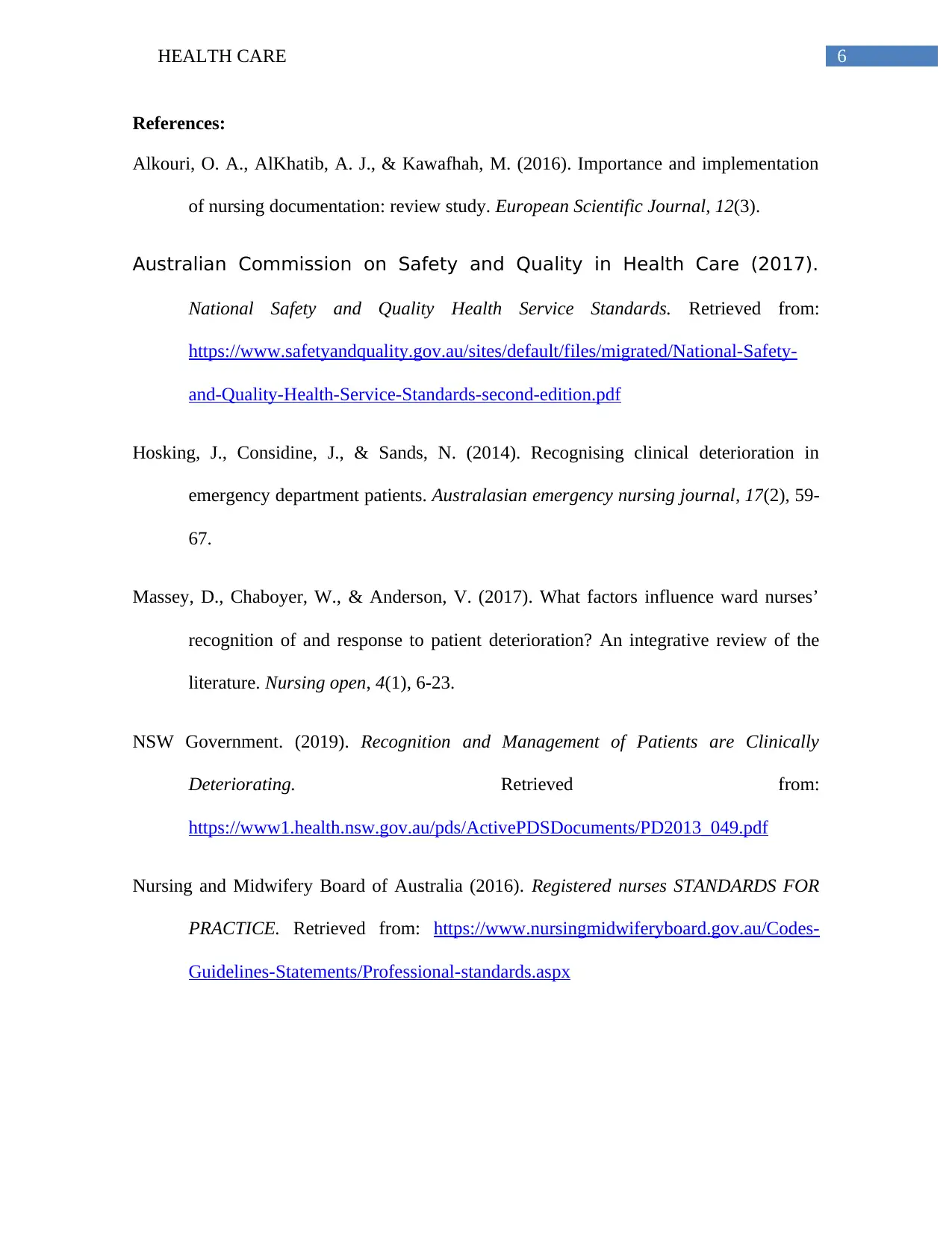
6HEALTH CARE
References:
Alkouri, O. A., AlKhatib, A. J., & Kawafhah, M. (2016). Importance and implementation
of nursing documentation: review study. European Scientific Journal, 12(3).
Australian Commission on Safety and Quality in Health Care (2017).
National Safety and Quality Health Service Standards. Retrieved from:
https://www.safetyandquality.gov.au/sites/default/files/migrated/National-Safety-
and-Quality-Health-Service-Standards-second-edition.pdf
Hosking, J., Considine, J., & Sands, N. (2014). Recognising clinical deterioration in
emergency department patients. Australasian emergency nursing journal, 17(2), 59-
67.
Massey, D., Chaboyer, W., & Anderson, V. (2017). What factors influence ward nurses’
recognition of and response to patient deterioration? An integrative review of the
literature. Nursing open, 4(1), 6-23.
NSW Government. (2019). Recognition and Management of Patients are Clinically
Deteriorating. Retrieved from:
https://www1.health.nsw.gov.au/pds/ActivePDSDocuments/PD2013_049.pdf
Nursing and Midwifery Board of Australia (2016). Registered nurses STANDARDS FOR
PRACTICE. Retrieved from: https://www.nursingmidwiferyboard.gov.au/Codes-
Guidelines-Statements/Professional-standards.aspx
References:
Alkouri, O. A., AlKhatib, A. J., & Kawafhah, M. (2016). Importance and implementation
of nursing documentation: review study. European Scientific Journal, 12(3).
Australian Commission on Safety and Quality in Health Care (2017).
National Safety and Quality Health Service Standards. Retrieved from:
https://www.safetyandquality.gov.au/sites/default/files/migrated/National-Safety-
and-Quality-Health-Service-Standards-second-edition.pdf
Hosking, J., Considine, J., & Sands, N. (2014). Recognising clinical deterioration in
emergency department patients. Australasian emergency nursing journal, 17(2), 59-
67.
Massey, D., Chaboyer, W., & Anderson, V. (2017). What factors influence ward nurses’
recognition of and response to patient deterioration? An integrative review of the
literature. Nursing open, 4(1), 6-23.
NSW Government. (2019). Recognition and Management of Patients are Clinically
Deteriorating. Retrieved from:
https://www1.health.nsw.gov.au/pds/ActivePDSDocuments/PD2013_049.pdf
Nursing and Midwifery Board of Australia (2016). Registered nurses STANDARDS FOR
PRACTICE. Retrieved from: https://www.nursingmidwiferyboard.gov.au/Codes-
Guidelines-Statements/Professional-standards.aspx
1 out of 7
Related Documents
Your All-in-One AI-Powered Toolkit for Academic Success.
+13062052269
info@desklib.com
Available 24*7 on WhatsApp / Email
![[object Object]](/_next/static/media/star-bottom.7253800d.svg)
Unlock your academic potential
Copyright © 2020–2025 A2Z Services. All Rights Reserved. Developed and managed by ZUCOL.





